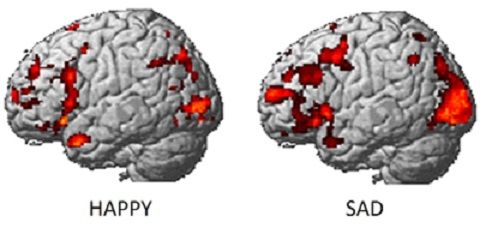Emotion, Memory, and Brain Scans
I still remember the first study I read as a psychology student. Canli et al. is surely a memorable study in every A Level psychology student’s life. This specific study made use of radiology in the most brilliant way possible and truly, to this date, it remains the most useful and foundational evidence in studying memory and emotion and the connection between emotions, memory and brain scans. Now you will be thinking is there really any connection? Or what do Brain scans has to do with emotions and memory right? Then don’t worry we have a very interesting study that focuses on The relationship between emotions, Memory and brain scans.

What Part of the Brain Controls Emotions? What is Amygdala??
The Amygdala, an almond-like part of the human brain located in the middle portion of the brain, adjacent to the Hippocampus, is what controls your emotions. There are multiple studies conducted related to this teeny tiny part of your brain, and each of those studies is very interesting. And in this blog, we have decided to discuss one of them.

Overview: Canli et al. 2000 Study
Turhan Canli along with Z. Zhao, J Brewer, J.D.E. Gabrieli, and L. Cahil conducted a radiology experiment to test the correlation between the intensity of emotions and memory by observing a part of the brain called the Amygdala in fMRIs. This single experiment has inspired multiple studies surrounding the neural activity in the amygdala and the neuroeconomic concept of value, which are incredibly interesting. In this blog, however, we are only going to look into the Canli T et al. study.
This case study is also a part of the A-Level Psychology curriculum, so if you are preparing for psych A-levels you might want to give this blog a read.
What Canli T et al. 2000 study is about?
We know, so far, that it’s something about emotions, memory, and this weird term called Amygdala. We also know that there is a role of fMRIs here which stands for Functional Magnetic Resonance Imaging. These scans look like this-

And that’s pretty much it in easy terms. Now let’s put them together and see what happened in this experiment. Firstly, let’s learn what an amygdala is- it is a small almond-like part in your brain which is involved with experiencing emotions. You might have heard about the ‘fight-or-flight’ response, that is directly associated with your Amygdala. Now what is interesting about the amygdala and what led to this whole experiment is the fact that it is also responsible for determining where the memories are stored in the brain and which ones are kept. So the question which arises is ‘what is the relation between emotions and memories?’
This study looks into brain scans and traces the links between the amygdala and memory for emotional experiences. Now that we have an overview let’s jump into the actual experiment.
Aims of the Study
There were just two very straightforward aims, 1. To show that emotive images will be remembered better than those that have a little emotional impact on an individual.
2. To understand whether the amygdala is sensitive to varying degrees of emotional intensity elicited by external stimuli and whether the level of intensity will affect the memory of the stimuli.
The answers to these may seem very obvious to you but remember that this was 22 years ago and this was meant to provide a piece of physical evidence and not promote word of mouth or common sense as clinically proven science.
The Procedure and the use of fMRI (the Fun Part)
Ten participants were selected for this experiment and all of them were right-handed consenting adult females. You may wonder why just like I did. The theory is that women were more likely to report intense emotional experiences openly and show more physiological reactions to the stimuli, which is a very useful trait for this experiment, and all right-handed cause the brain to have connections with the dominant hand and it was important for the participants to be as similar as possible so that the samples could be proven consistent.
These ten participants were in turns positioned in the 1.5 Tesla fMRI scanners and were shown a series of 96 scenes via an overhead projector and mirror. Those 96 scenes were from the ‘international affective picture system’ stimuli set. The order of the scenes was randomized, each of them was presented for 2.88 seconds with an interval of 12,96 seconds where the participants viewed a fixation cross and they had to indicate their emotional arousal by pressing a button with their right hand. The emotional arousal was scaled from 0 ‘not emotionally intense at all’ to 3 “extremely emotionally intense”.
Three weeks later, a surprise recognition test was conducted. During this, the participants viewed all the 96 previous scenes and 48 new scenes. They were asked if they had seen each scene before and for images, they judged as previously seen. They had to either report with their full certainty ‘remembered’ or if they felt less certain ‘forgotten or familiar’.

The Conclusions Of the Study
The Canli et al. 200 study concluded that the more emotionally intense an image, situation, or object is, the more likely is that it will be stored safely in your brain. This remains evident of why people remember the emotionally intense experiences so well and clearly. It was also concluded that the level of arousal a person is under could affect the strength of a memory trace. The amygdala is sensitive to individuals who experienced the emotional intensity of visual stimuli with activity in the left amygdala during encoding being predictive of subsequent memory.
So yes that was it about this study. To sum it up, Amygdala is an almond-like part of your brain which is responsible for your emotional experiences. It is shown that when the emotional intensity is high, whether the emotion is negative or positive, you are likely to recall the cause of the emotional experience well and with clarity.
We really hope that you learned something new. Until next time, stay healthy and safe.

